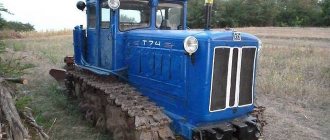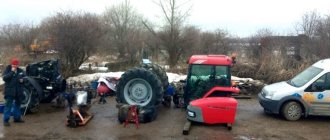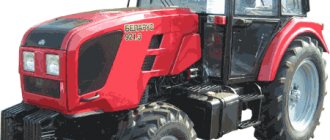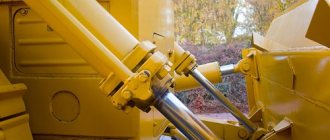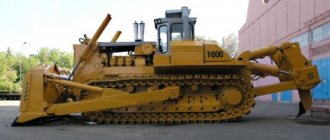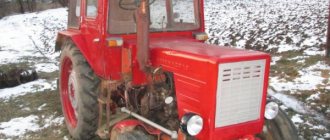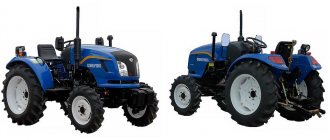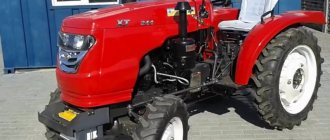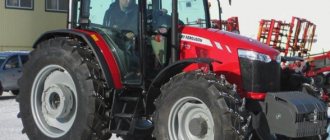The VT-100 tracked tractor is a general-purpose machine that has several modifications with a tractive effort of 3 or 4 tons. Production of this model has long been discontinued, but many copies still work in agriculture, land reclamation, road construction, utilities, construction and transport sectors. And you can buy a completely working unit at a low price.
Tractor VT-100
The author of this unit was the Volgograd (formerly Stalingrad) Tractor Plant, which for a long time was the main supplier of tracked vehicles in our country. The VT-100 model was a continuation and redesign of the popular DT-75 model, receiving an improved cabin, a more advanced engine, a hinged hood and a number of other improvements. To be specific, engine performance, for example, increased by one and a half times, and fuel consumption (per hectare) decreased by one fifth.
A rugged machine launched into mass production in 1994:
- It has an optimal combination of power and weight, and the use of ballast gives it excellent stability. Equipped with a pneumatic servo drive, which makes turning easier.
- It has a balanced spring running system with belt tracks, which makes the movement smooth and the pressure on the soil minimal.
- Allows quick access to the engine and radiator thanks to the hinged hood.
- It can be equipped with tracks of various purposes and widths (rice-growing, row-crop, with asphalt overlays, without lugs).
Easily connects via a hydraulic system to various mounted and trailed devices, including bulldozer equipment.
- It has several modifications (beet-growing, row-crop, swamp).
- Equipped with a spacious two-seater cabin with double glazing, good visibility and comfortable sprung seats.
In general, the tractor showed its best side, being reliable and very easy to operate. The only drawback is that you can’t always find spare parts (not everything from DT is suitable).
Photo of the VT-100 tractor

Crawler agricultural tractor based on VT-100
Modern transport » Crawler agricultural tractor based on VT-100
This project is on the topic: “Agricultural crawler tractor based on VT-100.” Special question: “Hydraulic shock absorber” consists of 4 sections: design, improvement of working conditions and safety, technological, economic and includes pages.
The design section describes the developed hydraulic shock absorber. This section presents the calculation of the shock absorber, the area of the passage opening, the calculation and construction of the traction characteristics of the tractor, as well as some test calculations of the main components of the tractor.
In the section on safety and environmental protection, a description is made of measures that help improve the working conditions of machine operators, fire safety and safety instructions.
In the technological section, a description of the unit and the purpose of the part is carried out, analysis of the manufacturability of the design, calculation of the assembly dimensional chain, selection of the type of workpiece, technological bases and methods of processing the part.
In the economic section, the calculation results for three production options are compared and the least costly one is selected.
Key words of the diploma project: tractor, suspension, hydraulic shock absorber, calculation.
Tractor manufacturing is one of the main components of the Russian agro-industrial complex, providing agriculture with mobile energy.
The needs of Russian agriculture for tractors are very great. In total, the fleet must have about 2.5 million different tractors, of which 30...35% should be tracked tractors of traction class 3...4, which are mainly produced by Volgograd Tractor Plant OJSC.
Currently, the needs of Russian agriculture for tractors are not fully satisfied. For example, their total number does not exceed 1.2 million, tracked - 400 thousand. Therefore, the main task of the tractor manufacturing industry is to increase the production of tractors if there is effective consumer demand for them.
An equally important task is to improve the technical level of tractors so that they most fully meet the modern requirements of agricultural technologies and other consumer demands.
The main directions of development of tractor manufacturing at the present stage include the following:
Increasing the unit power of tractors, which ensures an increase in their productivity, and this is especially important in the current conditions of reducing the number of machine operators in rural areas. For example, if the power of the main tractor of VgTZ OJSC 20 years ago was equal to 80 hp. (DT-75V), the currently produced tractor VT-100D has a power of 120 hp. Work is underway on 150 hp tractors. (VT-150) and even 175…200 hp. (VT-175). The K-744 wheeled tractor of the St. Petersburg Tractor Plant has a power of 350 hp.
Simultaneously with the increase in power, there is a tendency to increase the traction capabilities of tractors. So, if the DT-75V could work with the VT-175 up to 5 tons.
Expanding the possibility of aggregation with modern wide-cut, combined, driven machines and implements due to:
— increasing weight bearing capacity;
— increasing the load capacity of the rear linkage, installing the front linkage;
— the use of two-speed (540 and 1000 rpm) and even four-speed (540, 750, 1000 and 1400 rpm) power take-off shaft (PTO);
— installation of the front PTO;
— expanding the speed range, increasing the number of gears.
Increased fuel efficiency.
Use of progressive transmissions (powershift, continuously variable).
Improving the working conditions of the tractor driver (air conditioning, heater, seat and cab suspension, noise, vibration and heat insulation, good visibility and illumination, etc.).
Reducing the harmful impact of tractor running systems on the soil.
Increased smoothness, reduced vibration.
The issues of increasing smoothness have recently received special attention.
We install a hydraulic shock absorber in the suspension of a caterpillar tractor, which serves to dampen vibrations of the sprung part of the tractor, as well as partially dampen impacts from the chassis system on the frame. The hydraulic shock absorber increases the smoothness of the tractor's movement, which means it improves the working conditions of the tractor driver and the tractor.
- Description of known designs
- Hydraulic shock absorber of the T-150 tractor
- Hydropneumatic shock absorber for car suspension
- Hydraulic shock absorber with temperature limiter
- Hydropneumatic shock absorber for vehicle suspension
- Hydraulic telescopic shock absorber for vehicle suspension
- Telescopic shock absorber
- Comparative analysis of the described designs
- Calculation of pressure in the shock absorber taking into account the additional fluid bypass channel
- Shaft calculation
- Calculation of the final drive of the VT-100 tractor
- Traction characteristics of the VT-100D tractor
- Brief description of the unit and purpose of the part
- Part manufacturability analysis
- Calculation of assembly dimensional chain
- Selecting the type and method of obtaining the workpiece
- Selection of technological bases
- Selection of processing methods
- Technological route of processing and selection of the type of equipment, fixtures and tools
- Calculation of allowances for machining
- Calculation of cutting conditions and piece time standards
- Organization of the research and development process
- Assessment of the economic efficiency of the project
- Safety precautions
Popular on the site:
Safety precautions Only a technically sound unit may be used. This applies to both the technical condition of the chassis and the equipment installed on it. At the same time, they strictly follow the rules of vehicle operation and monitor the condition of the brakes, steering and the serviceability of electrical equipment...
Transport technology Transport technology includes (Fig. 4): track (as a structural element); vehicles (rolling stock); technical means of mechanization and automation of loading and unloading processes and transport and storage operations; computerized customer service systems; fur products...
Tools and parts used in straightening work Straightening levers and clamps are necessary for restoring deformed surfaces in hard-to-reach places. Before touching any surface, remove all trim, moldings, upholstery and other attached parts from the damaged area. If there are hatches providing d...
Device
Engine
The two main modifications differ precisely in the type of diesel engine. Thus, the name VT-100D means that the tractor is equipped with a D-442-24 engine produced by the Altai Motor Plant. And the VT-100N model is characterized by the SMD-20TA engine. However, both engines are of the same type - gas turbine supercharged and liquid cooled, differing in a few parameters.
The four cylinders of the engine located at the front of the tractor are lined up. This makes the diesel more compact and simplifies its maintenance. There is a two-valve type gas distribution mechanism. Operation is possible in two modes: drive and traction.
A special protection system is triggered when overheating or low pressure occurs. First, a signal is heard, and then the engine is turned off using
solenoid valve.
Transmission
The unit has a five-speed gearbox with permanently meshed gears. There is a high pressure forced lubrication system from the NSh-10 pump. The standard equipment includes a creeper, which allows you to increase the number of gears fivefold. It can be equipped with a reversible gearbox with a movable gear-type mechanism.
To carry out the rotation, a planetary type transmission is used. Driven gears with floating rings are used for final drives. The balance spring suspension has four rollers on each side.
Electrics
The voltage on board the crawler tractor (provided by the DC generator) is 12 volts. There are headlights in the rear and front parts, a lamp in the cabin, a lamp for illuminating the instrument panel, and sockets. The electrical system also includes a battery. There is a sound alarm system.
Hydraulics
The hydraulic system is built according to the separate-aggregate type. It consists of a hydraulic distributor (located at the rear, on the right wing), a gear pump, a tank and hydraulic cylinders. Hydraulics are mainly used to control mounted implements. In particular, a bulldozer blade.
Steering
You can vary the number of revolutions of the diesel shaft using a lever and a pedal. To turn, two levers and two pedals are used, which stop the moving tracks. When the clutch is engaged, the car stops or moves very slowly.
If you increase the number of revolutions, the tractor speeds up. Stopping is done in reverse order. Emergency braking is performed using the pedal.
Attachments
The complete tractor has a power take-off shaft designed for two speeds: 1000 and 540 rpm. Removable weights are placed in the front for balancing. For use in industrial conditions, the machine is equipped with a D3-42 bulldozer blade with a weight of 0.8 tons, a blade width of 2.56 meters, and a height of 0.8 meters.
As for agricultural equipment, you can use any (both hydraulically and non-hydroficated) that is designed to work with tractors of this class (3 and 4). Some units are hung from the front, others from the rear.
Specifications
Technical characteristics of the VT-100 tractor:
| Characteristics | Options | Unit measurements |
| engine's type | D-422-24 or SMD-20 TA | |
| For engine D-422-24: | ||
| Rotational speed (nominal) | 1750 | rpm |
| Torque reserve (traction mode) | 35 | % |
| Cylinder diameter | 13 | cm |
| Working volume | 7,43 | l |
| Fuel consumption (specific) | 220 | g/kWh |
| Forward speed (maximum) | 14,2 | km/h |
| Reverse speed (maximum) | 10,7 | km/h |
| Operating weight (with equipment, without ballast) | 7,58 | T |
| For SMD-20TA engine: | ||
| Rotational speed (nominal) | 1900 | rpm |
| Torque reserve (traction mode) | 25 | % |
| Cylinder diameter | 12 | cm |
| Working volume | 6,3 | l |
| Fuel consumption (specific) | 227 | g/kWh |
| Forward speed (maximum) | 14,6 | km/h |
| Reverse speed (maximum) | 11 | km/hour |
| Operating weight (with equipment, without ballast) | 7,48 | T |
| Common parameters: | ||
| Traction force (maximum) | 50 | kN |
| Ground pressure (specific) | 46 | kPa |
| Motor power (drive mode) | 106,8 | kW |
| Number of engine cylinders | 4 | PC. |
| Piston stroke | 14 | cm |
| Track size | 1,33 | m |
| Clearance | 0,42 | m |
| Weight (structural) | 7,69 | T |
| Removable ballast weight | 0,48 | T |
| Width | 1,85 | m |
| Cabin height | 3,12 | m |
| Length | 5,33 | m |
Video of the VT-100 tractor in operation:
VT-150 (tractor)
| This article lacks links to sources of information. Information must be verifiable, otherwise it may be questioned and deleted. You may edit this article to include links to authoritative sources. This mark was set on February 21, 2020 . |
| VT-90, VT-100, VT-150, VT-175, VT-200 | |
| Purpose | universal agricultural |
| Propulsion type | crawler |
| Traction class, tf | 3 (4) |
| Gross weight, t | 7,7 |
| Location | |
| Cabin: | rear (closed, ventilated) |
| Engine: | front |
| Engine | |
| Engine make | Diesel D-442VSI / 74DSE (SISUDIESEL) |
| Power, hp (kW) | 150 (110) |
| Transmission | |
| Transmission type | mechanical |
| Suspension and handling | |
| Rotation control method | planetary rotation mechanism with pneumatic serving |
| Equipment | |
| Pneumatic equipment | pneumatic control control; |
| The lineup | |
| Basic model | VT-100 |
| Subsequent model | VT-175 |
VT-90, VT-100, VT-150, VT-175, VT-200
general-purpose crawler agricultural tractors of traction class 3-4, equipped with a diesel engine. Designed to perform basic agricultural work together with mounted, semi-mounted and trailed implements, as well as machines with passive and active working parts. With the appropriate equipment, the tractor can be used for road construction, reclamation, loading and unloading, transport work and in conjunction with welding equipment. Based on the VT-100, VT-150, VT-175 tractors, modifications have been created: row-crop, beet-growing and peat (swamp) modifications.
At the request of consumers, VT-100, VT-150 and VT-175 and their modifications can be equipped with a creeper or reverse gear, tracks of various widths and purposes: row crop, rice-growing, without lugs, including with asphalt pads. These tractors are of the same type in design and differ in engine operating power. VT-90 is equipped with an A-41SI-01 or SISU 44DTA engine with a power of 95 hp. VT-100 with a D-442-24 or SMD-20TA engine (power in traction mode 120 hp, in drive mode 145 hp .). VT-150 - engine D-442VI with a power of 150 hp. VT-175 - engine D-4405 with a power of 170 hp. VT-200 - engine D-461VSI with a power of 215 hp. Tractors VT-175 and VT-200 have a torque converter in the transmission. The VT-200 tractor has five road wheels per side instead of four.
They produce the VT-150 tractor, OSP VMK KMZ.
| Tractors of Russia and CIS countries (see also Tractors of the USSR) | |
| Motoblocks and mini tractors | MTZ-09N | |
| Wheeled agricultural | VTZ-45 | |
| Wheeled industrial | K-702 | |
| Crawler agricultural | T-95 | |
| Tracked industrial | T-10 | |
| Skidding | TLT-100A "Onezhets-120" | |
| Tracked fire fighting | Onezhets-310 |
